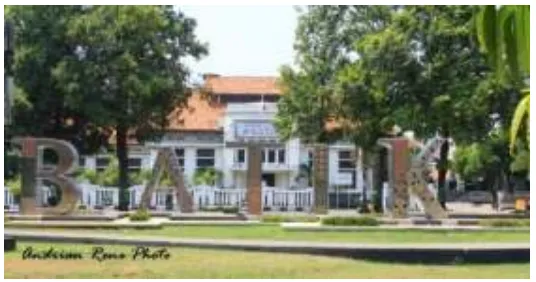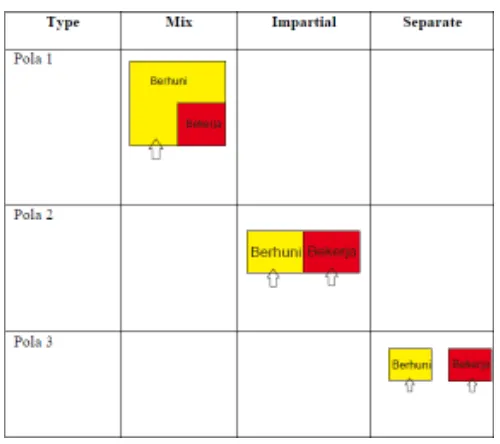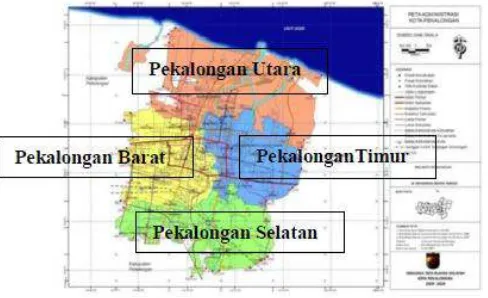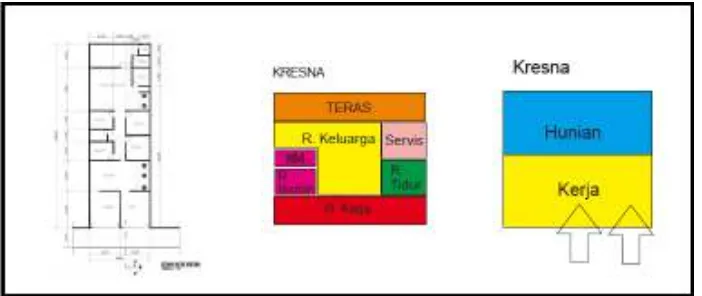MODEL OF BATIK PRODUCTIVE HOUSE ETHNIC CHINESE
IN PEKALONGAN
Etty R Kridarso1), Uras Siahaan2), Rumiati R Tobing3)
1
Lecturer,,Department of Architecture, Faculty of Civil Engineering and Planning Trisakti University, Jakarta 2
Lecturer, Department of Architecture, Christian University of Indonesia - Jakarta 3
Lecturer, Parahyangan Catholic University - Bandung [email protected]
ABSTRACT
House is a basic human need besides food and clothing. The main function of the house is as a place for shelter and as a place for developing the personality of its occupants. Meeting the needs of human desires can be fulfilled through the activity/work that earns money. The activities can be done by using the spaces at home. The house which has a mixed-function (habitable place and work) is referred to as a productive house. The focus of productive houses is directed to batik products, hereinafter referred to as a batik productive house. Pekalongan, a town on the northern coast of Java Island is famous for its batik products, as one of Indonesia's cultural heritage which is internationally recognized. As a coastal city, in the past centuries, Pekalongan played the role as a stopover for foreign traders, making the residents comprised of several ethnic groups, namely Javanese descents, Arabic descent and Chinese descent. Batik productive houses owned by the descendants of ethnic Chinese became the focus of this observation, because the Chinese descendants undertake batik product development in Pekalongan. This study is qualitative in nature. Data obtained through the study of literature as well as visual observation and recording. The result is in the model form of productive house, that can be used as a reference to the observations in similar conditions elsewhere and as an contribution into the development of environments with similar characteristics.
Keywords: productive house, ethnic Chinese, Pekalongan
A B S T R A K
Rumah merupakan kebutuhan dasar manusia selain sandang dan pangan. Fungsi rumah yang utama adalah sebagai tempat berhuni/berlindung serta tempat untuk mengembangkan kepribadian penghuninya. Pemenuhan kebutuhan dalam melangsungkan kehidupannya, manusia memerlukan suatu aktivitas/bekerja yang menghasilkan uang. Aktivitas tersebut dapat dilakukan dengan menggunakan ruang yang berada di rumah. Rumah yang mempunyai fungsi campuran (tempat berhuni dan bekerja) disebut sebagai rumah produktif. Rumah produktif yang menjadi focus adalah yang berkaitan dengan produk batik, selanjutnya disebut sebagai rumah produktif batik. Pekalongan, salah satu kota di pantai utara Pulau Jawa terkenal dengan produk batik, dimana produk batik merupakan salah satu warisan budaya Indonesia yang diakui secara Internasional. Sebagai kota pantai, Pekalongan pada abad lampau menjadi persinggahan pedagang asing, sehingga penduduk di kota Pekalongan terdiri dari beberapa etnis, yaitu Jawa/pribumi, keturunan etnis arab dan keturunan etnis cina. Rumah produktif batik yang dimiliki oleh keturunan etnis Cina menjadi focus pengamatan, karena keturunan etnis Cina merupakan salah satu penduduk yang mengusahakan pengembangan produk batik di Pekalongan. Telaah mengenai rumah produktif batik keturunan etnis Cina di Pekalongan menggunakan metode kualitatif, data diperoleh melalui studi literature serta observasi dan rekaman visual. Hasil akhir berupa model rumah produktif, diharapkan dapat menjadi referensi untuk pengamata n pada kondisi sejenis ditempat lain dan menjadi masukan untuk pengembangan lingkungan dengan cirik husus.
Kata kunci: rumah produktif, etnis cina, Pekalongan
1.
INTRODUCTION
One of the functions of the house that has been mentioned is place to earn a living. Thus the business independently can be done by using part of the house occupied space. Utilization of local potential business independently in order to be found in cities in Indonesia. One potential locally owned Indonesia and is recognized internationally as a typical Indonesian cultural heritage is the product Batik. Batik products recognized internationally on October 2 2009, making batik product sustainability is the responsibility of the entire Indonesian nation.
Pekalongan is one of the city located in the northern coast of Java Island, is the City as the embryo of batik in Indonesia which begins with the establishment of Indonesian Batik Cooperatives (GKBI) as an umbrella organization for the development of batik products. As a city located on the north coast, has a sea port that becomes a place for foreigners (Arabic, Chinese, Indian and European), so at this time resident in Pekalongan consists of a native (Java), descendants of Arabs and descendants of ethnic Chinese, Relics of European descent can be seen from the shape of the existing buildings in the town of Pekalongan, one of which is currently used as Museum Batik.
Figure 1. Location of Pekalongan in Java
Figure2. Batik Museum – Colonial Style Building
Pekalongan population of ethnic Chinese descent became the focus of observation, especially in relation to the business of batik products, because of ethnic Chinese descent are considered to represent the merchants whose presence in Indonesia was initiated with the intention to trade in order to seek a better life. Observations on special prolific home of batik products from Chinese ethnic keturunanan done by qualitative method, where data is obtained from compiling a literature study, observation, visual recordings and interviews. Step in the implementation of the observation begins with observations on the phenomenon of productive home, then the determination of local produce cultural value (batik); further by using the theory supporting analysis, then described the summary.
2.
BATIK PRODUCTIVE HOME
Pekalongan; the human element and the community is defined as a resident Pekalongan particularly ethnic Chinese descent; and a networking infrastructure that formed settlements in Pekalongan.
Figure 3 Relationship element in Built Environment
Based on the comparison of the space used for occupied and used to conduct economic activity / work (Silas, Johan, 2000: 233), earning home batik patterns of three types (Table 1), namely:
1. Mix Type, wherein the residence becomes one with business space; residence became the main function. Access to the residence together with access to the business space.
2. Impartial Type, houses separated by workplace / economic activity in the same building; in this case there are common interests between home as a shelter and a house as a place to work. Access to different homes with access to the business space.
3. Separate Type, this type of workplace is the dominant; residence is placed on the front or back of the owner's residence and sometimes even separate place, and it was used by workers. Access to different homes with access to the business space.
Table 1. Home productive batik based on patterns
flexible working time and the latter is a capital management is the separation between domestic capital and venture capital, which is marked with the machine / cash register
3.
ETHNIC CHINESE DESCENT
In Indonesian Dictionary (KBBI), the word 'descent' is derived from the word 'down' with the prefix of the word 'to' and the suffix the word 'an'. As for the meaning of the word 'descent' are grandchildren or generation or generations. A clearer understanding of the meaning of the word 'descendant' depends on the next word is complete. Ethnic Chinese or China is one of Indonesia's population whose presence has been recognized since the first century; where, according to records of the Chinese nation, the kingdoms were in Indonesia have Semarang, Pekalongan, Cirebon including Sumatra island, especially in the East, in Palembang.
Based on the description of the meaning of the word 'offspring' and 'ethnic Chinese', then the full meaning of the word 'ethnic descent China' is a next-generation descendants of the Indonesian population is derived from the Chinese, which came to Indonesia in search of a better life, especially with way trade. Similarly, the population of ethnic Chinese descent residing in Pekalongan, activities for a living is done by way of trade, one being traded is a superior product that is Batik Pekalongan.
4.
BATIK PRODUCTIVE HOME IN PEKALONGAN
Pekalongan city is divided into four administrative regions known as: North Pekalongan, Pekalongan East, South and West PekalonganPekalongan. Pekalongan center of activity is in the East, where this region are the town square as an orientation center city.
Figure 4. Map of Pekalongan with 4 (four) administrative area
Figure 5. Location of the four Productive Homes
Batik Kresna Productive Home
Batik KresnaProductive home, located on the street Hasanuddin on a row of shophouses. Earning house consists of one floor, where the part is used for the work is located on the front, and the portion used for habitable located on the back. The separation between the work and occupied parts not visible massive, but habitable activity and work is clearly visible separation. In Figure 6, looks plan the whole house of productive, next illustrated with color spaces of the house prolific Krishna, further illustrated that the portion used for work and parts that are used for habitable apart, though the driveway to get to the area occupied through the area for work. Earning home implements regular working hours as determined by the Government that is eight hours a day. Business owners are directly involved in work activities as well as implement the separation between venture capital and domestic capital.
Figure 6. Batik Kresna Productive Home
Batik Mukti Productive Home
Figure 7 Batik Mukti Productive Home
Batik Jong Productive Home.
Batik Jong Productive Home, located in the center of Pekalongan. In Figure 8 shows that the house is split between the productive work activities and habitable, where the working place and habitable located on different plots, are opposing. Business owners run their activities to the fullest by road every day at the scene of their operations and implement working time orderly and separate capital for businesses and households.
Figure 8. Batik Jong productive Home
Batik Teratai Indah Productive Home.
Teratai Indah Productive home shaped shop house consisting of two floors. In figure 8, it appears that the ground floor is used for work and the upper floors are used for habitable. To reach the place occupied by the ground floor of the portion used for car garage owner and a parking lot employee, if the activity of work in progress. Employees in carrying out the work have regular working hours as well as the existence of a clear separation between the capital to businesses and households.
5.
CONCLUSION
Based on data obtained regarding the Productive House of ethnic Chinese descent, it can be summarized as shown in table 2
Based on examination of four objects, it can be summarized that the house prolific descendants of ethnic Chinese have mixed models (work and habitable equal access), balanced (work and occupied have different access on the same land) or separate (work and occupied have access different on different land). Do not have the space that is shared between working and habitable except for access. Working time in accordance with the order established by the Government. Business owners there is a continuous monitoring or part-time and a separate venture capital among businesses and households.
REFERENCES
1. Kamus Besar Bahasa Indonesia (online)
2. http://digilib.uinsby.ac.id/9955/3/bab2.pdf - sejarah masuknya etnis cina/tionghoa ke Indonesia
3. Retnowati Kridarso, Etty (2016), Relasi antara Pola Tata Ruang Rumah Produktif Batik dengan Karakter Etnisitas di Kota Pekalongan, Jawa Tengah, Draft Disertasi, Universitas Katolik Parahyangan, Bandung. 4. Jurnal Nalars Volume 9 Nomor 1 Januari 2010: 73-82 – Anisa – Paradigma Penelitia
5. Broadbent Geoffrey. (1973); Design in Architecture, Architecture and Human Sciences; John Wiley & Sons, New York.USA.
6. Kuswartojo, Tjuk (2012), Perumahan dan Permukiman di Indonesia, ITB – Bandung
7. Silas, Johan danRekan, (2000); Rumah Produktif, Dalam Dimensi Tradisional Dan Pemberdayaan; UPT ITS - Surabaya.




